SEO
How To Do A Complete Local SEO Audit: 10-Point Checklist

At its core, SEO is a multi-faceted keyword, content, and competitive analysis exercise.
Local SEO, by extension, includes several specific tasks geared to establishing the relevance and authority of a business within a targeted geographic area.
Even before you can convince a local consumer your search result is the best answer, you must it prove to the search engines and earn a high enough ranking to get in the running.
Search engines like Google reference many different data points to determine who gets top billing in organic search engine results, featured snippets, maps, local packs, image, video, or other SERP features.
How can you identify and prioritize optimizations with the greatest potential to deliver converting traffic to your website and your door?
In this column, we’ll walk through an evaluation of each key facet of your local search presence and uncover your best opportunities to improve search rankings.
What does a comprehensive local SEO audit checklist entail?
- Keywords/SERPs.
- Website.
- Google Business Profile.
- Review management.
- Local business listings and citations.
- Local content.
- Google Search Console.
- Analytics.
- Backlinks.
- Competitor analysis.
These tasks are listed in typical order of completion during a full audit, but some can be accomplished concurrently.
1. Keyword/SERP Audit
The natural place to start a local SEO audit is in SERPs for the keywords and phrases you are hoping your business will be found for, in order to identify where you stand relative to your competitors and other websites/content.
This research can help you quickly identify where you have established some level of authority/momentum to build on, as well as keywords upon which you should not waste your time and effort.
SEO is a long-term strategy so no keyword should be summarily dismissed. Even so, it’s generally best to focus on those keywords you realistically have a chance to rank and drive traffic for.
You may determine some keywords are better pursued in the short term via a paid Google Ads strategy until you are able to build up your local organic authority.
There are several excellent SEO and keyword research tools available to automate the process of gathering search results for specific or topical groups of keywords and assigning value to keywords based on metrics such as search volume or keyword difficulty.
Ideally, you’ll choose a tool that will break down the different types of search features, so you can understand whether you or a competitor has secured any of this search real estate and then devise strategies or tactics to proceed accordingly.
Alternatively, you can conduct your own searches manually. In that case, do so in an Incognito Window in Google Chrome or Private Window in Safari to remove potential bias/personalization tied to your Google login, location, or personal search history.
Most automation tools have processes in place to do the same.
For those businesses also running PPC campaigns, close attention should be paid to the keywords and search terms working there.
It’s likely that top-performing PPC keywords will also be top performers from an SEO perspective.
SEO and PPC should complement each other for optimal results.
Different people search in different ways and it’s important to not limit your research to single keywords, but rather account for the various ways and phrases your audience may use to try to find you or your offerings.
Your keyword analysis and the resulting content you create should address the intent of searchers, which will vary depending on where they are in the buying cycle.
Some are just beginning their search for a product or service and are simply looking for information e.g. “Where can I find x?”, while others are ready to buy now e.g. “Order x near me.”
A broader keyword view will provide a better picture of the overall strength of your presence and where to best focus your attention.
2. Website Audit
With your focused keyword data in hand, you can now conduct a full keyword and technical website audit to ensure your site is optimized for maximum crawlability, indexability, and visibility.
A typical audit is designed to analyze the underlying structure, content, and overall site experience.
Here again, there are many site auditing tools that will crawl a website and then identify issues and prioritize actions to be taken based on SEO best practices.
A website audit and optimization can be broken down into several buckets.
Page Optimization
Web page optimization is all about ensuring pages are well structured, focused around topical keywords and provide a positive user experience.
As a search engine crawls a web page it looks for signals to determine what the page is about and what questions it can answer.
These crawlers analyze the entire page to determine its focus but specifically focus on Page Titles and Headings as primary descriptors.
Ideally, pages are keyword-focused and unique.
As such, keyword variations should be used consistently in Titles, URLs, Headings, and meta descriptions.
Google, and the other search engines, appreciate well-structured pages and will grab or create the components they need to construct a search engine result similar to the one below for “breakfast in Barrie.”
Note how the keyword “breakfast” is highlighted in the meta description.
Specifically, an audit will highlight issues related to:
- Missing Title tags, or those that are too long (60 characters max) or duplicated.
- Headings (particularly H1s) that are missing or duplicated.
- Meta descriptions that are missing, too long (160 characters max), or duplicated.
Another important potential tag issue raised in an audit, depending on the nature of your local business, is image alt text.
As a best practice, all images should include relevant descriptive filenames and alt text, which may include pertinent keywords.
This becomes particularly important when images (e.g. product or service photos) are central to your business, as image carousels can and will show up in Web search results.
In every case, attention should be paid to the images appearing on your primary ranking pages.
Internal Link Audit
Over time, the various links within a website can become stale or outdated as content is moved or deleted.
A link audit will help you quickly identify any potential misdirected or broken links, which can create a less than optimal experience for your site visitors.
Links are likewise signals the search engines use to determine the flow of a website and its ability to direct searchers to appropriate, authoritative answers to their questions.
Part of this audit should include the identification of opportunities to crosslink prominent pages.
For example, if a page within your site has keywords that reference content on another page a link may be created.
This can have the effect of boosting both pages, provided the link logically guides users to more relevant content or an appropriate conversion point.
External links should also be considered, especially when there is an opportunity to link to an authoritative source of information.
From a local business perspective, this may include linking to relevant local organizations or events.
Pro tip: These links should ideally be opened in new browser windows, so your site visitors are able to continue on your site after they have explored any external links.
Schema Review
Featured snippets are increasingly superseding traditional organic search results in Google, as the search engine aims to provide the answers to questions directly within its SERPs.
Local businesses have an opportunity to have their content highlighted as featured snippets if they:
- Publish highly authoritative and relevant content.
- Use structured schema markup to tag content such as their local business details, products, events, FAQs.
An effective local SEO audit should include the identification of content within a website to which schema can be applied.
Mobile Audit
As more consumers begin searching via their mobile devices – especially for local services – it naturally becomes important for local businesses to provide a positive mobile web experience.
It will, in turn, affect how they are viewed and ranked by the search engines.
In short, websites need to load quickly, be easily navigated, and enable seamless user interaction.
Google offers a range of free mobile testing and three mobile-specific monitoring tools (Page Experience, Core Web Vitals, Mobile Usability) in Google Search Console.
More on this toolset below.
More in-depth user experience and SEO analysis can be done via Google Lighthouse, though a local business owner will likely want to enlist the help of a web developer to action any of the recommendations this tool provides.
Duplicate Content
High-quality, authoritative content is, by definition, original content.
As such, it’s important to let Google know if your website contains any content/pages which you did not create, by adding a canonical tag to the HTML header of the page.
Not doing so can have a detrimental effect on your authority and, by extension, your ability to rank.
Most site auditing tools will flag content that requires or has malformed canonical tags.
3. Google Business Profile Audit
A Google Business Profile (GBP) effectively represents a secondary website and highly visible point of presence for most local businesses.
An accurate, comprehensive GBP is critical to establishing visibility in Google Maps and organic search results.
A Google Business Profile audit should focus on the accuracy and completeness of the various components within the profile including:
- Business information and location details.
- Correct primary business category.
- Hours of operation.
- Correct pin location in Google Maps.
- Proper categorization as a physical location or service area business.
- Products.
- Services.
- Photos.
- Offers.
- Updates.
- Events.
- Appointment link(s).
- Informational content.
The more complete the profile is, the more likely it will be viewed as a reliable local resource and be given appropriate billing in the search results.
Assuming you have claimed and are authorized to manage your GBP, you can access and edit your info directly within the search results.
 Screenshot from Google Business Profile, February 2022
Screenshot from Google Business Profile, February 20224. Review Management
Another very important aspect of a GBP is reviews.
Local business customers have an opportunity and are increasingly willing to write reviews, which appear on the GBP for other customers to view and play a significant role in determining visibility in the local map pack.
Google will notify business owners as soon as reviews are submitted and they should be responded to ASAP. This goes for negative reviews just as much as positive ones.
However, we all get busy and so a complete audit should include an analysis of your reviews to ensure none have fallen through the cracks. This will also help determine whether there are recurring customer service and satisfaction issues or themes that need to be addressed.
Of course, there are also several other places for consumers to submit reviews including Facebook, local review sites like Yelp, and industry-specific sites such as TripAdvisor and Houzz.
A full audit should take inventory of reviews left on any of these services as they can show up in search results.
The search engines and savvy modern consumers will most certainly find them.
A quick way to discover what reviews you may have on lesser-known properties is to simply search “‘your business name’ reviews.”
Alternatively, here too there are several good software platforms designed to help business owners ask for and manage their reviews on GBP and other review sites.
Pro tip: Request positive reviews from all customers and politely suggest they reference the product or service they are reviewing, as this can have a positive effect from a keyword ranking perspective.
5. Local Business Listing/Citation Audit
Local business listings and citations provide search engines with a way of confirming a business are both local and reputable within a specific geographic region.
It is important to have a presence in reputable local directories, review sites, business directories (e.g. Chamber of Commerce), or local partner sites.
Depending on the size and scope of your local business an audit of your listings and citations can be done in an automated or manual fashion.
Business listings and citation management tools can be used to find, monitor and update all primary citations with your proper Name, Address, Phone Number (aka NAP), and other pertinent business details found in broader listings (e.g. website address, business description.)
If you manage a limited number of locations and have the time, one quick method of identifying where your current listings can be found is to simply conduct a search on your business name.
The first 3-4 pages of search results should reveal the same.
If the goal is to understand where you are missing listing and citation opportunities, you can conduct a search on the list of keywords you have researched and want to be found for.
The most valuable directories and listing sites will be those which appear in the search results for these keywords.
It’s also important that you find and resolve any duplicate listings to prevent confusing customers and search engines alike with outdated, inaccurate information.
6. Local Content Audit
As noted, people search differently and require different types of information depending on where they are in their buying journey.
A well-structured local web presence will include content tailored and distributed for consumption during each stage of this journey, to bolster visibility and awareness.
You want to be found throughout your customer’s search experience.
A content audit can be used to make sure you have content for each of the journey buckets your audience members may find themselves in.
Informational content may be distributed via social or other external channels or published on your website to help educate your consumers on the products, services, and differentiators you offer at the beginning of their path to purchase.
This content ideally answers your prospects’ why, how, and what type questions.
Transactional content is designed to address those consumers who already know what they want, but are in the process of deciding where or who to purchase from.
This type of content may include reviews, testimonials, or competitive comparisons.
Navigational content ensures when people click through from Google after having searched your brand name or a variation thereof, they land on a page or information validating your position as a leader in your space.
This page should also include a clear call to action with the assumption they have arrived with a specific goal in mind.
Commercial content addresses those consumers who have signaled a strong intent to buy.
Effective local business sites and social pages must include offers, coupons, discounts, and clear paths to purchase.
Quality content is content your audience wants to consume, like, and share. In 2022, for many businesses, this means considering and experimenting with content beyond text and images.
Video content shared via platforms like YouTube, Instagram, Facebook, TikTok, and others is easier to consume and generally more engaging.
YouTube videos, in particular, can be optimized and do appear within organic search results.
Keep in mind, each social network includes a search function and any content distributed here should incorporate targeted keywords and hashtags to enhance visibility.
Pro tip: Make it easy for your readers to like and share your content by including visible share buttons; a simple best practice missed by far too many website owners.
While social signals are not a search ranking factor, shared content has a higher chance of being linked to, which in turn can positively affect authority and organic visibility.
7. Google Search Console Review
Google Search Console is an invaluable free resource for data related to keyword and content performance, indexing, schema/rich results validation, mobile/desktop experience monitoring, and security/manual actions.
A complete local SEO audit must include a review and analysis of this data to identify and react to strengths, weaknesses, opportunities, and threats outlined in each section.
Website owners and managers will want to pay particular attention to any issues related to pages not being crawled/indexed or manual actions having been taken based on questionable practices, as both can have a detrimental effect on search engine visibility.
Google Search Console does send notifications for these types of issues as well as regular performance updates, but an audit will ensure nothing has been overlooked.
 Screenshot from Google Search Console, February 2022
Screenshot from Google Search Console, February 20228. Analytics Review
Whether you are using Google Analytics or another site/visitor tracking solution, the data available here is useful during an audit to validate top and lesser-performing content, traffic sources, audience profiles, and paths to purchase.
Findings in analytics will be key to your content audit.
As you review your site analytics you may ask the following questions:
- Are my top-visited pages also my top ranking pages in search engines?
- Which are my top entry pages from organic search?
- Which pages/content are not receiving the level of traffic or engagement desired?
- What is the typical path to purchase on my site and can it be condensed or otherwise optimized?
- Which domains are my top referrers and are there opportunities to further leverage these sites for backlinks? (see Backlink Audit below).
Use Google Analytics (or another tool of your choice) to find the answers to these questions so you can focus and prioritize your content and keyword optimization efforts.
9. Backlink Audit
Backlinks or inbound links are similar to citations but are effectively any links to your website pages from other third-party websites.
Links remain an important factor in determining the authority of a website as they lend validity if they come from relevant, reputable sources.
However, links from non-relevant or non-reputable sites can do more harm than good from an SEO perspective, and sometimes these links can be created without your knowledge.
It is therefore wise to conduct a backlink audit every six to twelve months depending on the size and scope of your website.
As with other components of an audit, there are several good free and paid backlink tools available, including a link monitoring service in Google Search Console, which is a great place to start.
 Screenshot from Google Search Console, February 2022
Screenshot from Google Search Console, February 2022In terms of auditing linking domains, you should quickly determine if there are any you don’t recognize or those which appear non-reputable or irrelevant to your local business.
Depending on the source, nature of the link, and the content it links to, it may be necessary to inquire about having the link removed.
An effective backlink audit has the dual purpose of identifying and building links via potentially valuable backlink sources, which can positively affect your ranking and visibility.
For local businesses, reputable local sources of links are naturally beneficial in validating location.
Potential backlink sources can be researched in a variety of locations:
- Free and paid backlink research tools such as Ahrefs, Semrush, or Majestic. Identify any domains where your primary competition has acquired backlinks, but you have not.
- Any non-competitive sites appearing in the organic search results for your primary keywords are, by definition, good potential backlink sources. Look for directories you can be listed in, blogs or articles you can comment on or publications you can submit articles to.
- Referral sources in Google Analytics may reveal domains where you already have links and may be able to acquire more.
10. Competitor Analysis
A comprehensive local SEO audit would not be complete without identifying and reviewing the strengths and weaknesses of your competition.
You may already have a good sense of who your competition is, but to begin it’s always a good idea to confirm who specifically shows up in the search results when you enter your target keywords.
These businesses/domains are your true competitors and the sites you can learn the most from.
A recent Google algorithm update appears to signal more emphasis is being placed on results tied to the immediate proximity of a business, which means the most attention should be paid to your closest high-ranking competitors.
If any of these competitors’ sites and/or pages are ranking ahead of yours, you’ll want to review what they may be doing to gain this advantage.
You can follow the same checklist of steps you would conduct for your own audit to identify how they may be optimizing their keywords, content, Google Business Profile, reviews, local business listings, or backlinks.
In general, the best way to outperform your competition is to provide a better overall experience online and off, which includes generating more relevant, high-quality content to address the questions your mutual customers have.
Prioritizing Your Action Items
A complete local SEO audit is going to produce a fairly significant list of action items.
Many of the aforementioned keyword, site, content, and backlink auditing tools do a good job of prioritizing tasks; however, the list can still be daunting.
One of the best places to start with an audit action plan is around the keywords and content you have already established some but not enough authority for.
These are your keywords, webpages, and content assets sitting on the cusp of prominence in the local organic search results and Map Packs.
Determine how to best address deficiencies or opportunities to optimize this content first before moving onto more competitive keywords or those you have less or no visibility for, as we all know, SEO is a long-term game.
These audit items and should be reviewed every 6-12 months, depending on the size and scale of your web presence, for the best chance at being found by your local target audience.
More resources:
Featured Image: Ribkhan/Shutterstock
SEO
Measuring Content Impact Across The Customer Journey

Understanding the impact of your content at every touchpoint of the customer journey is essential – but that’s easier said than done. From attracting potential leads to nurturing them into loyal customers, there are many touchpoints to look into.
So how do you identify and take advantage of these opportunities for growth?
Watch this on-demand webinar and learn a comprehensive approach for measuring the value of your content initiatives, so you can optimize resource allocation for maximum impact.
You’ll learn:
- Fresh methods for measuring your content’s impact.
- Fascinating insights using first-touch attribution, and how it differs from the usual last-touch perspective.
- Ways to persuade decision-makers to invest in more content by showcasing its value convincingly.
With Bill Franklin and Oliver Tani of DAC Group, we unravel the nuances of attribution modeling, emphasizing the significance of layering first-touch and last-touch attribution within your measurement strategy.
Check out these insights to help you craft compelling content tailored to each stage, using an approach rooted in first-hand experience to ensure your content resonates.
Whether you’re a seasoned marketer or new to content measurement, this webinar promises valuable insights and actionable tactics to elevate your SEO game and optimize your content initiatives for success.
View the slides below or check out the full webinar for all the details.
SEO
How to Find and Use Competitor Keywords

Competitor keywords are the keywords your rivals rank for in Google’s search results. They may rank organically or pay for Google Ads to rank in the paid results.
Knowing your competitors’ keywords is the easiest form of keyword research. If your competitors rank for or target particular keywords, it might be worth it for you to target them, too.
There is no way to see your competitors’ keywords without a tool like Ahrefs, which has a database of keywords and the sites that rank for them. As far as we know, Ahrefs has the biggest database of these keywords.
How to find all the keywords your competitor ranks for
- Go to Ahrefs’ Site Explorer
- Enter your competitor’s domain
- Go to the Organic keywords report
The report is sorted by traffic to show you the keywords sending your competitor the most visits. For example, Mailchimp gets most of its organic traffic from the keyword “mailchimp.”


Since you’re unlikely to rank for your competitor’s brand, you might want to exclude branded keywords from the report. You can do this by adding a Keyword > Doesn’t contain filter. In this example, we’ll filter out keywords containing “mailchimp” or any potential misspellings:
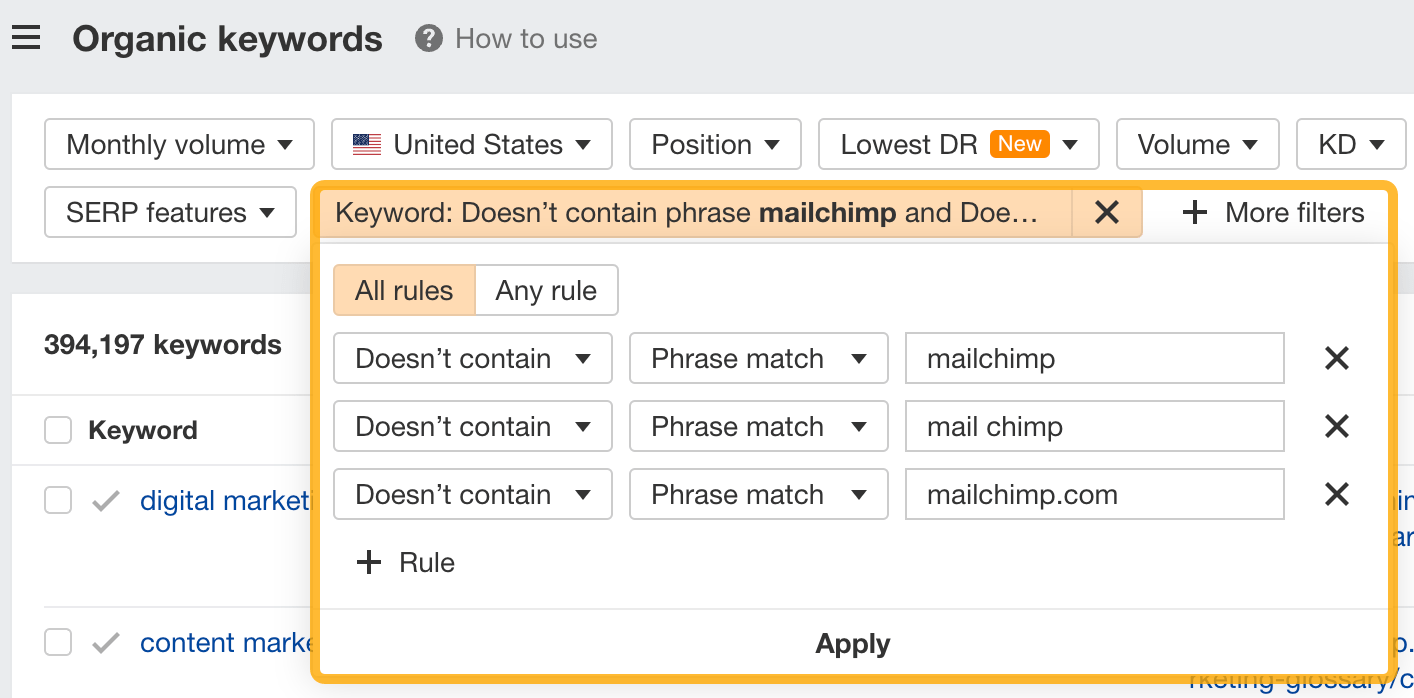

If you’re a new brand competing with one that’s established, you might also want to look for popular low-difficulty keywords. You can do this by setting the Volume filter to a minimum of 500 and the KD filter to a maximum of 10.


How to find keywords your competitor ranks for, but you don’t
- Go to Competitive Analysis
- Enter your domain in the This target doesn’t rank for section
- Enter your competitor’s domain in the But these competitors do section


Hit “Show keyword opportunities,” and you’ll see all the keywords your competitor ranks for, but you don’t.


You can also add a Volume and KD filter to find popular, low-difficulty keywords in this report.


How to find keywords multiple competitors rank for, but you don’t
- Go to Competitive Analysis
- Enter your domain in the This target doesn’t rank for section
- Enter the domains of multiple competitors in the But these competitors do section
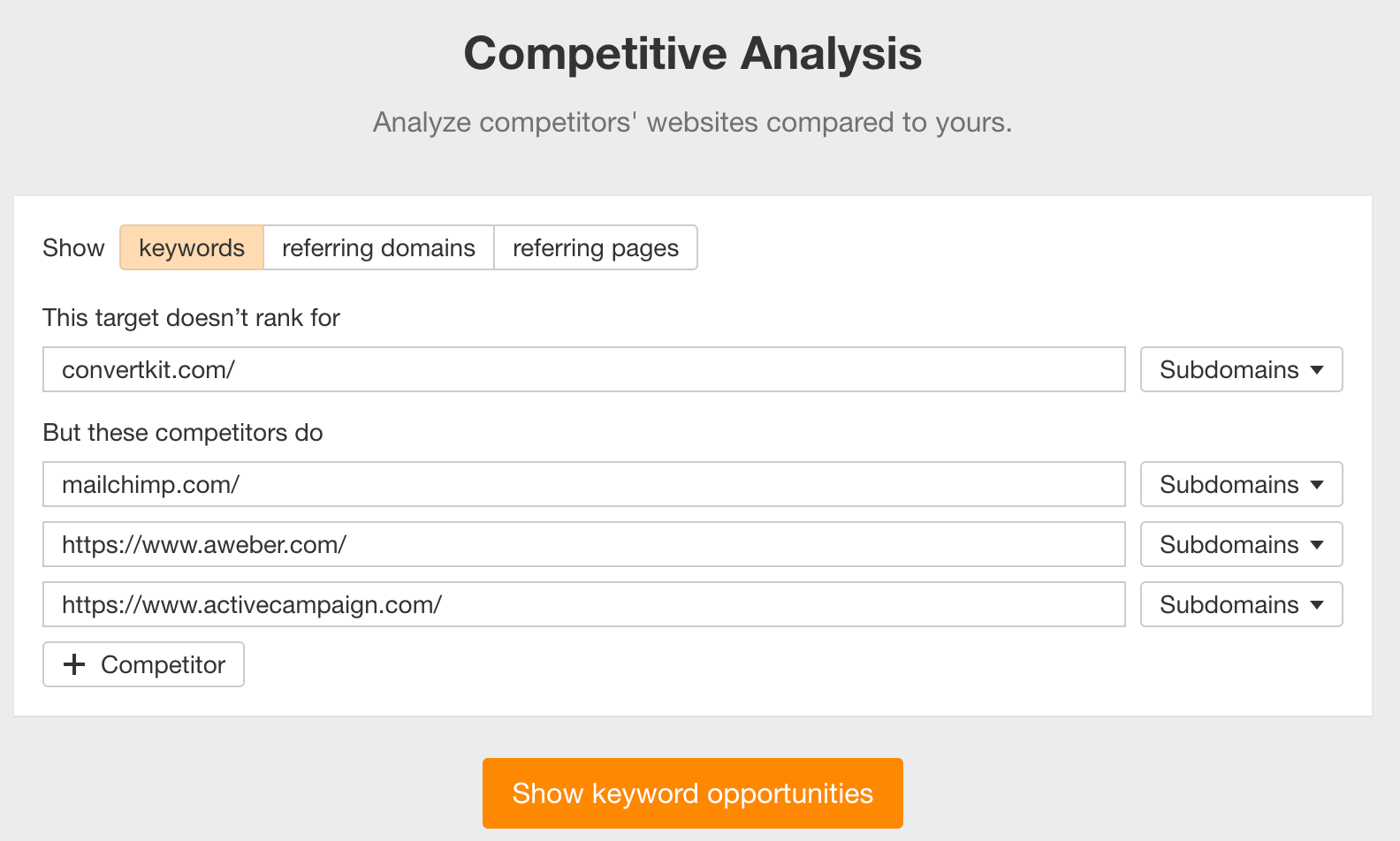

You’ll see all the keywords that at least one of these competitors ranks for, but you don’t.


You can also narrow the list down to keywords that all competitors rank for. Click on the Competitors’ positions filter and choose All 3 competitors:


- Go to Ahrefs’ Site Explorer
- Enter your competitor’s domain
- Go to the Paid keywords report
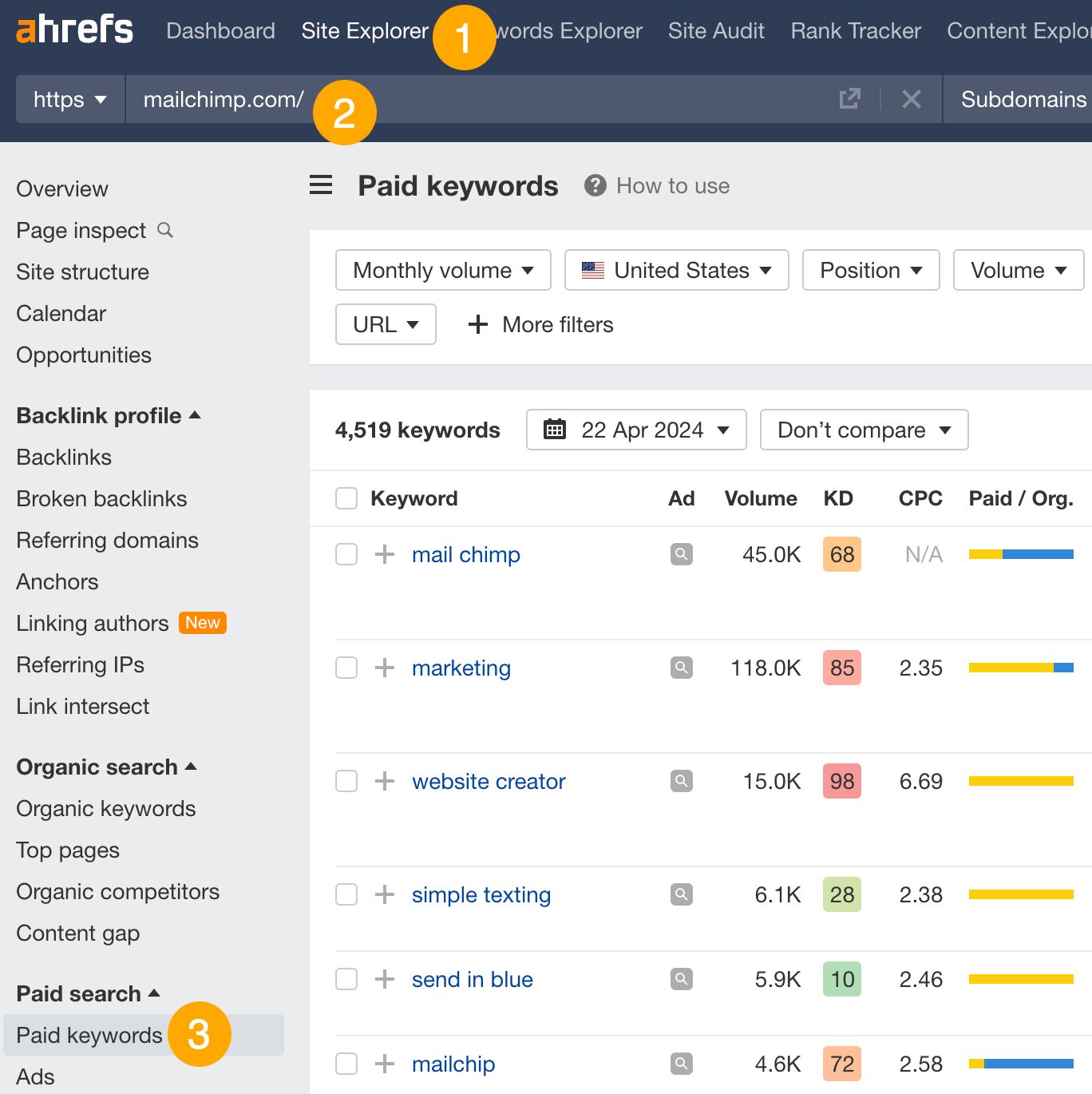

This report shows you the keywords your competitors are targeting via Google Ads.
Since your competitor is paying for traffic from these keywords, it may indicate that they’re profitable for them—and could be for you, too.
You know what keywords your competitors are ranking for or bidding on. But what do you do with them? There are basically three options.
1. Create pages to target these keywords
You can only rank for keywords if you have content about them. So, the most straightforward thing you can do for competitors’ keywords you want to rank for is to create pages to target them.
However, before you do this, it’s worth clustering your competitor’s keywords by Parent Topic. This will group keywords that mean the same or similar things so you can target them all with one page.
Here’s how to do that:
- Export your competitor’s keywords, either from the Organic Keywords or Content Gap report
- Paste them into Keywords Explorer
- Click the “Clusters by Parent Topic” tab


For example, MailChimp ranks for keywords like “what is digital marketing” and “digital marketing definition.” These and many others get clustered under the Parent Topic of “digital marketing” because people searching for them are all looking for the same thing: a definition of digital marketing. You only need to create one page to potentially rank for all these keywords.
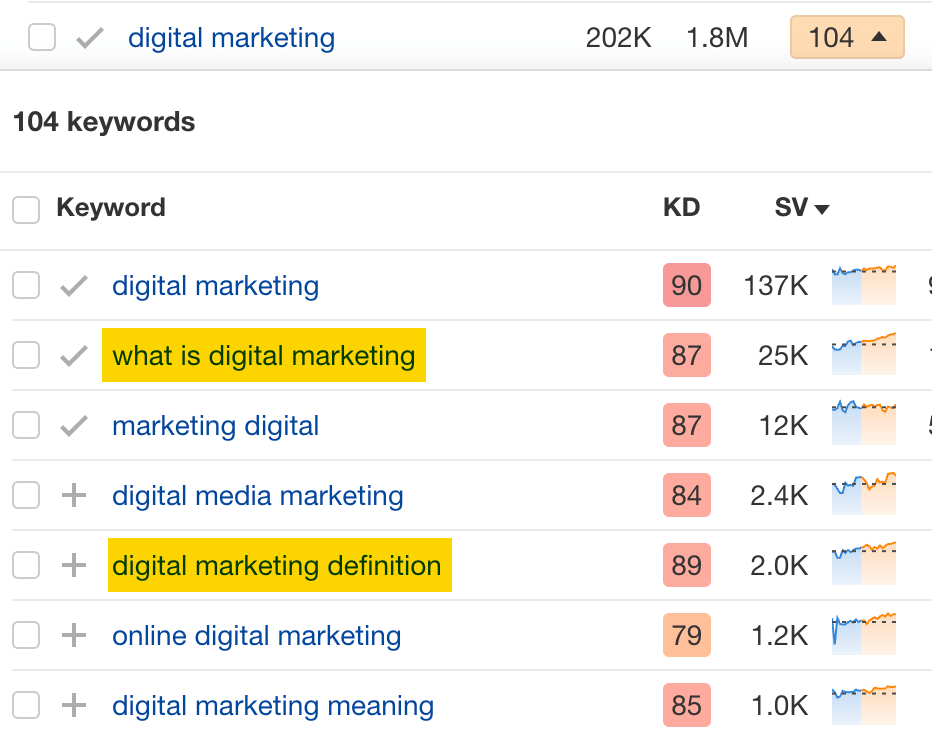

2. Optimize existing content by filling subtopics
You don’t always need to create new content to rank for competitors’ keywords. Sometimes, you can optimize the content you already have to rank for them.
How do you know which keywords you can do this for? Try this:
- Export your competitor’s keywords
- Paste them into Keywords Explorer
- Click the “Clusters by Parent Topic” tab
- Look for Parent Topics you already have content about
For example, if we analyze our competitor, we can see that seven keywords they rank for fall under the Parent Topic of “press release template.”


If we search our site, we see that we already have a page about this topic.


If we click the caret and check the keywords in the cluster, we see keywords like “press release example” and “press release format.”
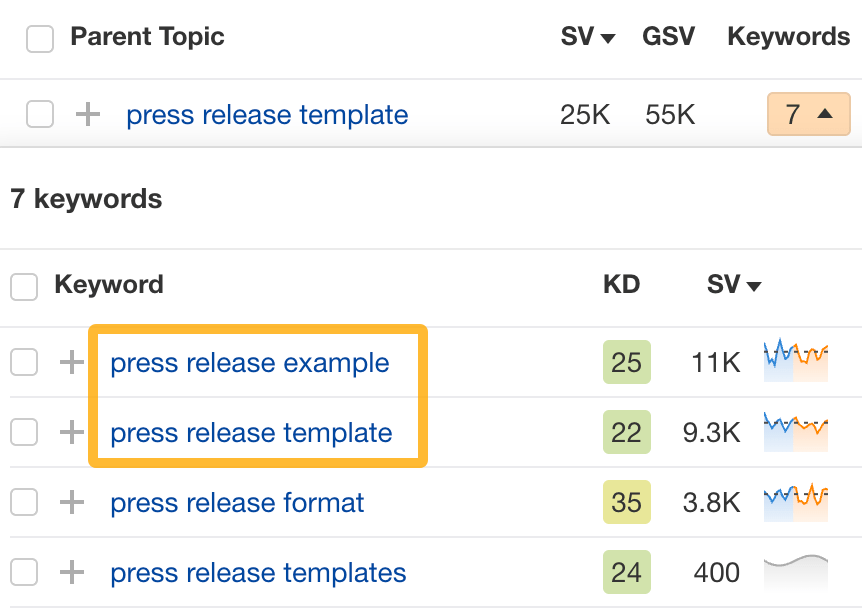

To rank for the keywords in the cluster, we can probably optimize the page we already have by adding sections about the subtopics of “press release examples” and “press release format.”
3. Target these keywords with Google Ads
Paid keywords are the simplest—look through the report and see if there are any relevant keywords you might want to target, too.
For example, Mailchimp is bidding for the keyword “how to create a newsletter.”


If you’re ConvertKit, you may also want to target this keyword since it’s relevant.
If you decide to target the same keyword via Google Ads, you can hover over the magnifying glass to see the ads your competitor is using.
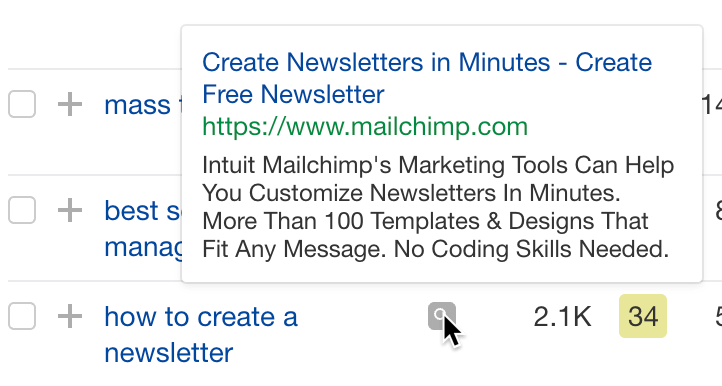

You can also see the landing page your competitor directs ad traffic to under the URL column.


Learn more
Check out more tutorials on how to do competitor keyword analysis:
SEO
Google Confirms Links Are Not That Important

Google’s Gary Illyes confirmed at a recent search marketing conference that Google needs very few links, adding to the growing body of evidence that publishers need to focus on other factors. Gary tweeted confirmation that he indeed say those words.
Background Of Links For Ranking
Links were discovered in the late 1990’s to be a good signal for search engines to use for validating how authoritative a website is and then Google discovered soon after that anchor text could be used to provide semantic signals about what a webpage was about.
One of the most important research papers was Authoritative Sources in a Hyperlinked Environment by Jon M. Kleinberg, published around 1998 (link to research paper at the end of the article). The main discovery of this research paper is that there is too many web pages and there was no objective way to filter search results for quality in order to rank web pages for a subjective idea of relevance.
The author of the research paper discovered that links could be used as an objective filter for authoritativeness.
Kleinberg wrote:
“To provide effective search methods under these conditions, one needs a way to filter, from among a huge collection of relevant pages, a small set of the most “authoritative” or ‘definitive’ ones.”
This is the most influential research paper on links because it kick-started more research on ways to use links beyond as an authority metric but as a subjective metric for relevance.
Objective is something factual. Subjective is something that’s closer to an opinion. The founders of Google discovered how to use the subjective opinions of the Internet as a relevance metric for what to rank in the search results.
What Larry Page and Sergey Brin discovered and shared in their research paper (The Anatomy of a Large-Scale Hypertextual Web Search Engine – link at end of this article) was that it was possible to harness the power of anchor text to determine the subjective opinion of relevance from actual humans. It was essentially crowdsourcing the opinions of millions of website expressed through the link structure between each webpage.
What Did Gary Illyes Say About Links In 2024?
At a recent search conference in Bulgaria, Google’s Gary Illyes made a comment about how Google doesn’t really need that many links and how Google has made links less important.
Patrick Stox tweeted about what he heard at the search conference:
” ‘We need very few links to rank pages… Over the years we’ve made links less important.’ @methode #serpconf2024″
Google’s Gary Illyes tweeted a confirmation of that statement:
“I shouldn’t have said that… I definitely shouldn’t have said that”
Why Links Matter Less
The initial state of anchor text when Google first used links for ranking purposes was absolutely non-spammy, which is why it was so useful. Hyperlinks were primarily used as a way to send traffic from one website to another website.
But by 2004 or 2005 Google was using statistical analysis to detect manipulated links, then around 2004 “powered-by” links in website footers stopped passing anchor text value, and by 2006 links close to the words “advertising” stopped passing link value, links from directories stopped passing ranking value and by 2012 Google deployed a massive link algorithm called Penguin that destroyed the rankings of likely millions of websites, many of which were using guest posting.
The link signal eventually became so bad that Google decided in 2019 to selectively use nofollow links for ranking purposes. Google’s Gary Illyes confirmed that the change to nofollow was made because of the link signal.
Google Explicitly Confirms That Links Matter Less
In 2023 Google’s Gary Illyes shared at a PubCon Austin that links were not even in the top 3 of ranking factors. Then in March 2024, coinciding with the March 2024 Core Algorithm Update, Google updated their spam policies documentation to downplay the importance of links for ranking purposes.
The documentation previously said:
“Google uses links as an important factor in determining the relevancy of web pages.”
The update to the documentation that mentioned links was updated to remove the word important.
Links are not just listed as just another factor:
“Google uses links as a factor in determining the relevancy of web pages.”
At the beginning of April Google’s John Mueller advised that there are more useful SEO activities to engage on than links.
Mueller explained:
“There are more important things for websites nowadays, and over-focusing on links will often result in you wasting your time doing things that don’t make your website better overall”
Finally, Gary Illyes explicitly said that Google needs very few links to rank webpages and confirmed it.
I shouldn’t have said that… I definitely shouldn’t have said that
— Gary 鯨理/경리 Illyes (so official, trust me) (@methode) April 19, 2024
Why Google Doesn’t Need Links
The reason why Google doesn’t need many links is likely because of the extent of AI and natural language undertanding that Google uses in their algorithms. Google must be highly confident in its algorithm to be able to explicitly say that they don’t need it.
Way back when Google implemented the nofollow into the algorithm there were many link builders who sold comment spam links who continued to lie that comment spam still worked. As someone who started link building at the very beginning of modern SEO (I was the moderator of the link building forum at the #1 SEO forum of that time), I can say with confidence that links have stopped playing much of a role in rankings beginning several years ago, which is why I stopped about five or six years ago.
Read the research papers
Authoritative Sources in a Hyperlinked Environment – Jon M. Kleinberg (PDF)
The Anatomy of a Large-Scale Hypertextual Web Search Engine
Featured Image by Shutterstock/RYO Alexandre
-

 PPC5 days ago
PPC5 days ago19 Best SEO Tools in 2024 (For Every Use Case)
-

 MARKETING6 days ago
MARKETING6 days agoStreamlining Processes for Increased Efficiency and Results
-
SEARCHENGINES6 days ago
Daily Search Forum Recap: April 17, 2024
-

 SEO6 days ago
SEO6 days agoAn In-Depth Guide And Best Practices For Mobile SEO
-

 PPC6 days ago
PPC6 days ago97 Marvelous May Content Ideas for Blog Posts, Videos, & More
-
SEARCHENGINES5 days ago
Daily Search Forum Recap: April 18, 2024
-

 MARKETING6 days ago
MARKETING6 days agoEcommerce evolution: Blurring the lines between B2B and B2C
-
SEARCHENGINES4 days ago
Daily Search Forum Recap: April 19, 2024
















You must be logged in to post a comment Login